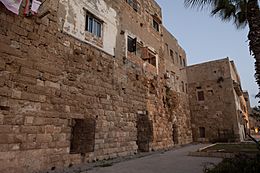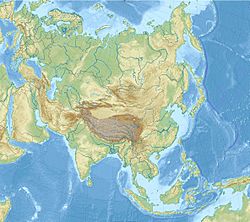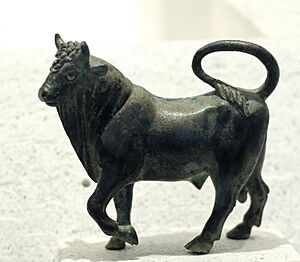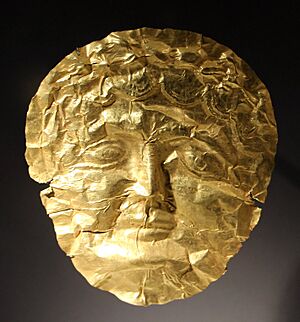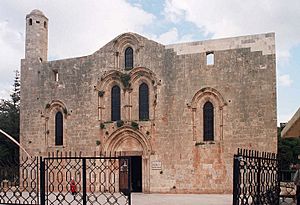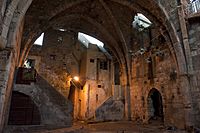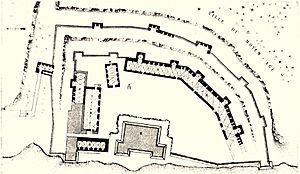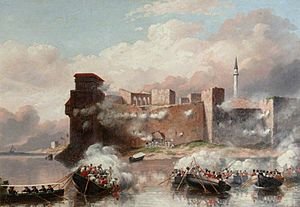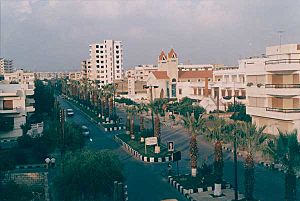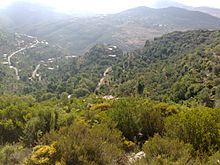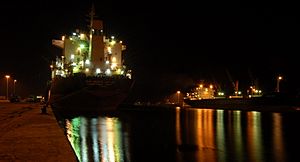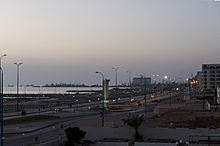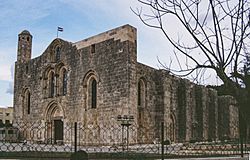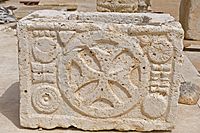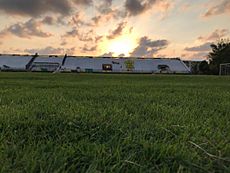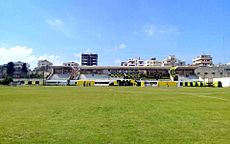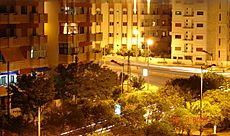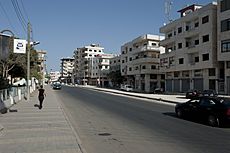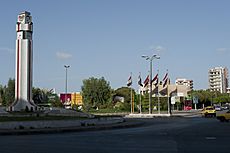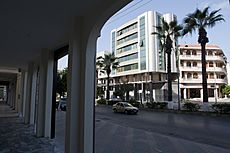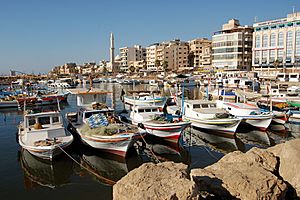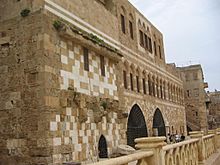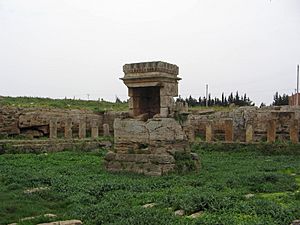Tartus facts for kids
Quick facts for kids
Tartus
طَرْطُوس
Tortosa
|
||
|---|---|---|
|
City
|
||
|
Tartus corniche
Port of Tartus • Tartus beach and boulevard Cathedral of Our Lady of Tortosa • Al-Assad Stadium Citadel of Tartus |
||
|
||
| Nickname(s):
Rope; (Arabic: حبل)
|
||
| Country | ||
| Governorate | Tartus Governorate | |
| District | Tartus District | |
| Subdistrict | Tartus Subdistrict | |
| Established | 2nd millennium BC | |
| Founded by | Phoenicians | |
| Area | ||
| • Land | 20 km2 (8 sq mi) | |
| Elevation | 22 m (72 ft) | |
| Population
(2004 census)
|
||
| • City | 115,769 | |
| • Metro | 162,980 | |
| Demonym(s) | Arabic: طرطوسي, romanized: Ṭarṭūsi | |
| Time zone | UTC+2 (EET) | |
| • Summer (DST) | UTC+3 (EEST) | |
| Area code(s) | Country code: 963, City code: 43 | |
| Geocode | C5221 | |
| Climate | CSa | |
| Website | eTartus | |
Tartus (Arabic: طَرْطُوس / ALA-LC: Ṭarṭūs), also known as Tortosa in the past, is a city on the Mediterranean coast of Syria. It is the second largest port city in Syria, after Latakia. Tartus is also the biggest city in the Tartus Governorate, which became a separate region in the 1970s.
In 2004, the city had a population of 115,769 people. During the summer, Tartus is a popular vacation spot for many Syrians. You can find many resorts and vacation homes in the area. The port also hosts a small Russian naval base.
Contents
What's in a Name?
The ancient Phoenician people founded the city. They named it Antarados, which means "The town facing Arwad." This name came from the Greek words Anti-Arados.
Later, the Romans called it Tortosa in Latin. The current Arabic name, Ṭarṭūs, comes from this original name. The French name Tartous and the English name Tartus are also based on Ṭarṭūs.
A Look Back in Time
Ancient Beginnings
The history of Tartus began around 2000 BC. It was founded by the Phoenicians as a colony of Arwad, a very important island city nearby. This mainland settlement was called Antaradus. Not much is left of the Phoenician city today.
Roman and Byzantine Eras
During the Roman Empire, the city was known as Antaradus. People believed the city was special because of its strong devotion to the Virgin Mary. The first chapel dedicated to the Virgin Mary was built here in the 3rd century.
Early Islamic Period
In 634 AD, Islamic rule began in Syria. Arab armies conquered Tartus in 636 AD, led by Ubada ibn as-Samit. Mu'awiya I, an important leader, helped build up the city. He also gave land to the soldiers stationed there.
The Crusader Era
The Crusaders, who were European knights, called the city Tortosa. They captured it in 1099 during the First Crusade. After taking the city, they built a large cathedral over an older Byzantine church. This cathedral became a popular place for pilgrims.
In 1152, the city was given to the Knights Templar, a powerful group of warrior monks. They made Tortosa their military headquarters. The Templars built a strong castle around 1165. It had a large chapel and strong double walls to protect the city from attacks.
In 1188, the Muslim leader Saladin recaptured Tortosa. The main Templar headquarters moved to Cyprus. However, some Templars stayed in the castle's keep, which is the strongest part of a castle. They held onto it for another 100 years, making its defenses even stronger. Finally, in 1291, the keep also fell. Tortosa was the very last place the Templars held on the Syrian mainland. After this, they moved to the nearby island of Arwad for a short time.
Ottoman Rule
During the Ottoman Empire's rule, Tartus became important again because of trade with Cyprus and Europe. Its port was very strategic for defense. In 1832, the city was taken by Muhammad Ali Pasha, the ruler of Egypt.
In 1840, during a war between Egypt and the Ottoman Empire, British ships attacked the citadel in Tartus. Even with heavy fighting, the British could not capture the fort. After the war, the city returned to the Ottoman Empire and remained under their rule until 1918.
Modern Times
Tartus has continued to grow and develop in modern times.
City Landscape
Tartus is located on the eastern coast of the Mediterranean Sea. To the east, it is bordered by the Syrian Coastal Mountain Range. Arwad, the only inhabited island on the Syrian coast, is just a few kilometers offshore. The city sits on a coastal plain, with mountains made mostly of limestone to its east.
Weather in Tartus
Tartus has a Mediterranean climate. This means it has mild, wet winters and hot, dry summers. There are also short periods of change in April and October. The mountains to the east make the climate cooler and bring more rain. Tartus is known for its mild weather and higher rainfall compared to other parts of Syria.
| Climate data for Tartus | |||||||||||||
|---|---|---|---|---|---|---|---|---|---|---|---|---|---|
| Month | Jan | Feb | Mar | Apr | May | Jun | Jul | Aug | Sep | Oct | Nov | Dec | Year |
| Mean daily maximum °C (°F) | 15.8 (60.4) |
16.4 (61.5) |
18.6 (65.5) |
21.9 (71.4) |
24.8 (76.6) |
27.3 (81.1) |
29.2 (84.6) |
30.0 (86.0) |
29.2 (84.6) |
26.6 (79.9) |
22.4 (72.3) |
17.9 (64.2) |
23.34 (74.01) |
| Daily mean °C (°F) | 12.0 (53.6) |
12.7 (54.9) |
14.7 (58.5) |
17.6 (63.7) |
20.3 (68.5) |
23.9 (75.0) |
26.0 (78.8) |
26.7 (80.1) |
25.1 (77.2) |
21.9 (71.4) |
17.7 (63.9) |
13.7 (56.7) |
19.36 (66.85) |
| Mean daily minimum °C (°F) | 8.4 (47.1) |
8.9 (48.0) |
10.4 (50.7) |
12.8 (55.0) |
15.6 (60.1) |
19.1 (66.4) |
22.2 (72.0) |
22.8 (73.0) |
20.4 (68.7) |
16.9 (62.4) |
13.2 (55.8) |
10.0 (50.0) |
15.06 (59.11) |
| Average rainfall mm (inches) | 177.5 (6.99) |
142.1 (5.59) |
105.2 (4.14) |
57.1 (2.25) |
20.0 (0.79) |
12.3 (0.48) |
0.7 (0.03) |
3.8 (0.15) |
8.2 (0.32) |
67.6 (2.66) |
105.0 (4.13) |
184.8 (7.28) |
884.3 (34.81) |
| Average rainy days (≥ 1.0 mm) | 12.5 | 10.2 | 9.3 | 5.4 | 2.1 | 0.5 | 0.1 | 0.1 | 0.8 | 4.4 | 6.5 | 11.0 | 62.9 |
| Source: Hong Kong Observatory | |||||||||||||
Economy and Industry
Trade and Production
Tartus is a very important trade center in Syria. It has one of the country's two main ports on the Mediterranean Sea. The port is growing a lot, as many goods for rebuilding Iraq come through Tartus.
The city also has a large cement factory that makes 6,500 tons of cement every day. The pharmaceutical industry is also growing, with seven new factories opening recently. Food, chemical, and wood processing industries are also found in the city's industrial area.
Many people in Tartus work in the service sector, like tourism or other helpful jobs. A high number of people with good education work in these areas.
Tourism in Tartus
Tartus is a favorite place for tourists. It is a modern city with nice buildings, markets, and resorts. The beaches of Tartus stretch for about 90 km along the Syrian coast. They have soft sand, chalets, hotels, and restaurants. The city has seen new investments in tourism, like the Antaradus and Porto waterfront projects.
Tartus hosts a Soviet-era naval base. This base provides supplies and maintenance for Russian ships. It is the last Russian military base outside the former Soviet Union. It is also Russia's only fueling spot in the Mediterranean Sea. This saves Russian warships from having to travel all the way back to their Black Sea bases.
Culture and Arts
Festivals and Music
Tartus hosts many cultural events, art festivals, and theater shows. In the summer, the Tartous Art Festival takes place, featuring famous Syrian and Arab artists. There is also a tourist festival called Antaradus.
Famous composers Assi Rahbani and Mansour Rahbani often visited Tartus. They loved the city and even wrote a song called Shabab Al-Hilweh about it. Many talented artists, like singer Farrah Yousef and actor Taim Hasan, are from Tartus. The city has also been home to many poets and writers.
Tartus Museum
The Cathedral of Our Lady of Tortosa was built in the 12th century by the Knights Templar. Over time, it was used as a mosque and then as army barracks. Since 1956, this historic building has been the National Museum of Tartus. It displays ancient items found in the region, including from Amrit.
In 2021, the museum began a big project to restore and fix its old architectural parts.
Sports in Tartus
Tartus is home to one sports club, Al-Sahel SC, founded in 1971. The club has teams for football, basketball, table tennis, and bodybuilding. They play in two stadiums in the city: the Municipal Stadium (which holds 1,300 people) and Bassel Al-Assad Stadium (which holds 8,000 people).
In 2018, Al-Sahel's football team reached the top Syrian Premier League for the first time. The women's basketball team also plays at the highest level in Syria.
Education Opportunities
Tartus has several colleges that are part of Tishreen University in Latakia. These include colleges for Arts and Technical Engineering. These colleges help expand higher education in Syrian cities.
The city also has many institutes, high schools, and primary schools. These are run by the Ministry of Education. There are also many private schools and educational centers.
City Life and Transport
Tartus has grown and developed a lot, like other cities in Syria. It has seen much urban development, with new neighborhoods and an expanded city plan. The city also has beautiful parks, like Al-Basel Park, which are great places for people to relax.
The new sea corniche, a walkway along the coast, adds to the city's charm. Many people from other parts of Syria, Europe, and Arab countries visit Tartus to enjoy its beautiful sea views. The city is special because it is surrounded by mountains and forests, offering lovely natural scenery.
Getting Around Tartus
Tartus has a good road system. The M1 international highway connects Tartus and Latakia. The city is also connected to Damascus by the M5 highway through Homs. There are plans to build a new international road linking Tartus to Iraq and the Arab Gulf. This would be the shortest route from the Arab Gulf to the Mediterranean Sea through the Port of Tartus. Al-Thawra Street, named after the 1963 March Revolution, is the main commercial road along the coast.
The railway network, run by Chemins de Fer Syriens, connects Tartus to other Syrian cities. Currently, passenger trains run between Latakia and Tartus, and between Tartus, Al Akkari, and Homs. There are also talks about restoring the rail link with Iraq and extending the railway from Iraq to Tartus.
Places to See
The old part of Tartus has newer buildings built on and inside the walls of the Crusader-era Templar fortress. The moat of the fortress still separates this old town from the modern city. Outside the fortress, you can see the old Romanesque and Gothic Cathedral of Notre-Dame of Tartus, which dates back to the 12th century.
Tartus and the areas around it are full of ancient sites and historical places. Many important sites are just a short drive away from the city. These include:
- The old city of Tartus.
- Margat Castle, north of the city.
- The historic town of Safita.
- Arwad island and its castle.
- The ancient Cathedral of Our Lady of Tortosa, now the city museum.
- Beit el-Baik Palace.
- Sheikh Saleh al-Ali shrine in Al-Shaykh Badr.
- Hosn Suleiman Temple.
- Drekish town-resort.
Besides these historical sites, there are also modern attractions like:
- Alrimal Alzahabeya beach resort.
- Junada hotel (formerly Porto Tartous).
- Holiday beach resort.
- Mashta Al Helou resort.
The town of Al Hamidiyah, just south of Tartus, is interesting because it has a Greek-speaking population. These people are descendants of Greek Muslims from the island of Crete. Their ancestors moved there in the late 19th century as refugees.
International Connections
Sister Cities
Tartus is twinned with these cities:
Famous People from Tartus
- Saadallah Wannous (1941–1997), a famous playwright.
- Sheikh Saleh Al-Ali, a Syrian revolutionary who fought against the French.
- Dr. Halim Barakat, a novelist and sociologist.
- Mohammad Yousaf Abu al-Farah Tartusi, a Muslim saint.
- Jamal Suliman, an actor.
- Taim Hasan, a well-known actor.
- Farrah Yousef, a singer and finalist on Arab Idol Season 2.
- Assef Shawkat, a former deputy Minister of Defense of Syria.
- Mohsen Saeed Hussein Khaddour, a Syrian Arab Army officer known as Lion of Al-Badia.
See also
 In Spanish: Tartús para niños
In Spanish: Tartús para niños







